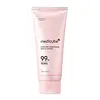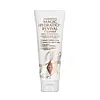What's inside
What's inside
 Key Ingredients
Key Ingredients

 Benefits
Benefits

 Concerns
Concerns

 Ingredients Side-by-side
Ingredients Side-by-side

Water
Skin ConditioningGlycerin
HumectantMyristic Acid
CleansingStearic Acid
CleansingPotassium Hydroxide
BufferingLauric Acid
CleansingNiacinamide
SmoothingGlyceryl Stearate Se
EmulsifyingGlycol Distearate
EmollientPalmitic Acid
EmollientCocamidopropyl Betaine
CleansingPotassium Cocoyl Glycinate
Sodium Polyacrylate
AbsorbentSorbitan Olivate
EmulsifyingSorbitol
HumectantAllantoin
Skin ConditioningPotassium Cocoate
EmulsifyingPolyquaternium-10
Sodium Chloride
MaskingPolyquaternium-7
Butylene Glycol
HumectantCaprylyl Glycol
EmollientAcrylates/C10-30 Alkyl Acrylate Crosspolymer
Emulsion StabilisingTetrasodium EDTA
Anthemis Nobilis Flower Oil
MaskingPyrus Communis Fruit Extract
Skin ConditioningRosa Damascena Flower Water
MaskingPrunus Persica Fruit Extract
AbrasiveThuja Orientalis Extract
AntimicrobialCyanocobalamin
Skin ConditioningJasminum Officinale Flower Water
MaskingCitrus Aurantium Amara Flower Extract
RefreshingRosmarinus Officinalis Leaf Oil
MaskingCucumis Melo Fruit Extract
Skin ConditioningHedera Helix Leaf/Stem Extract
Antimicrobial1,2-Hexanediol
Skin ConditioningPanthenol
Skin ConditioningSodium Dna
Skin ConditioningSodium Benzoate
MaskingCoptis Chinensis Root Extract
AntioxidantEthylhexylglycerin
Skin ConditioningGluconolactone
Skin ConditioningGlutathione
Capryloyl Salicylic Acid
ExfoliatingSalicylic Acid
MaskingCaprylic/Capric Triglyceride
MaskingAdansonia Digitata Seed Oil
EmollientHydrogenated Lecithin
EmulsifyingPentylene Glycol
Skin ConditioningCeramide NP
Skin ConditioningMadecassoside
AntioxidantCorchorus Olitorius Leaf Extract
Skin ConditioningCarum Petroselinum Extract
Skin ConditioningHibiscus Esculentus Fruit Extract
Skin ConditioningDecyl Glucoside
CleansingDimethylsilanol Hyaluronate
HumectantHydrolyzed Hyaluronic Acid
HumectantHydrolyzed Sodium Hyaluronate
Skin ConditioningSodium Hyaluronate
HumectantPotassium Hyaluronate
Skin ConditioningHyaluronic Acid
HumectantCeramide As
Skin ConditioningCeramide Ns
Skin ConditioningHydroxypropyltrimonium Hyaluronate
Sodium Hyaluronate Crosspolymer
HumectantSodium Hyaluronate Dimethylsilanol
HumectantCeramide AP
Skin ConditioningCeramide EOP
Skin ConditioningSodium Acetylated Hyaluronate
HumectantWater, Glycerin, Myristic Acid, Stearic Acid, Potassium Hydroxide, Lauric Acid, Niacinamide, Glyceryl Stearate Se, Glycol Distearate, Palmitic Acid, Cocamidopropyl Betaine, Potassium Cocoyl Glycinate, Sodium Polyacrylate, Sorbitan Olivate, Sorbitol, Allantoin, Potassium Cocoate, Polyquaternium-10, Sodium Chloride, Polyquaternium-7, Butylene Glycol, Caprylyl Glycol, Acrylates/C10-30 Alkyl Acrylate Crosspolymer, Tetrasodium EDTA, Anthemis Nobilis Flower Oil, Pyrus Communis Fruit Extract, Rosa Damascena Flower Water, Prunus Persica Fruit Extract, Thuja Orientalis Extract, Cyanocobalamin, Jasminum Officinale Flower Water, Citrus Aurantium Amara Flower Extract, Rosmarinus Officinalis Leaf Oil, Cucumis Melo Fruit Extract, Hedera Helix Leaf/Stem Extract, 1,2-Hexanediol, Panthenol, Sodium Dna, Sodium Benzoate, Coptis Chinensis Root Extract, Ethylhexylglycerin, Gluconolactone, Glutathione, Capryloyl Salicylic Acid, Salicylic Acid, Caprylic/Capric Triglyceride, Adansonia Digitata Seed Oil, Hydrogenated Lecithin, Pentylene Glycol, Ceramide NP, Madecassoside, Corchorus Olitorius Leaf Extract, Carum Petroselinum Extract, Hibiscus Esculentus Fruit Extract, Decyl Glucoside, Dimethylsilanol Hyaluronate, Hydrolyzed Hyaluronic Acid, Hydrolyzed Sodium Hyaluronate, Sodium Hyaluronate, Potassium Hyaluronate, Hyaluronic Acid, Ceramide As, Ceramide Ns, Hydroxypropyltrimonium Hyaluronate, Sodium Hyaluronate Crosspolymer, Sodium Hyaluronate Dimethylsilanol, Ceramide AP, Ceramide EOP, Sodium Acetylated Hyaluronate
Water
Skin ConditioningGlycerin
HumectantSodium Cocoyl Glycinate
CleansingDisodium Cocoyl Glutamate
CleansingCitric Acid
BufferingDecyl Glucoside
CleansingGlyceryl Stearate Se
EmulsifyingSodium Cocoyl Glutamate
CleansingSodium Benzoate
MaskingGlycol Distearate
EmollientPentylene Glycol
Skin ConditioningCetyl Hydroxyethylcellulose
Emulsion StabilisingHydrolyzed Cottonseed Protein
Skin ConditioningFructose
HumectantSodium Hydroxide
BufferingUrea
BufferingParfum
MaskingOpuntia Ficus-Indica Stem Extract
Skin ConditioningTetrasodium Glutamate Diacetate
Allantoin
Skin ConditioningMaltose
MaskingSodium Chloride
MaskingSodium Lactate
BufferingSodium PCA
HumectantTrehalose
HumectantSodium Hyaluronate
HumectantPhenoxyethanol
PreservativeAloe Barbadensis Leaf Juice Powder
Skin ConditioningButyrospermum Parkii Butter
Skin ConditioningSodium Ascorbyl Phosphate
AntioxidantTocopheryl Acetate
AntioxidantCamellia Oleifera Seed Oil
Skin ConditioningRosa Canina Fruit Oil
EmollientHelianthus Annuus Seed Oil
EmollientDisodium EDTA
Potassium Sorbate
PreservativeDisodium Phosphate
BufferingHydrated Silica
AbrasiveGlucose
HumectantSilica Dimethyl Silylate
EmollientSodium Phosphate
BufferingPlumeria Rubra Flower Extract
Skin ConditioningTocopherol
AntioxidantHexyl Cinnamal
PerfumingBenzyl Benzoate
AntimicrobialWater, Glycerin, Sodium Cocoyl Glycinate, Disodium Cocoyl Glutamate, Citric Acid, Decyl Glucoside, Glyceryl Stearate Se, Sodium Cocoyl Glutamate, Sodium Benzoate, Glycol Distearate, Pentylene Glycol, Cetyl Hydroxyethylcellulose, Hydrolyzed Cottonseed Protein, Fructose, Sodium Hydroxide, Urea, Parfum, Opuntia Ficus-Indica Stem Extract, Tetrasodium Glutamate Diacetate, Allantoin, Maltose, Sodium Chloride, Sodium Lactate, Sodium PCA, Trehalose, Sodium Hyaluronate, Phenoxyethanol, Aloe Barbadensis Leaf Juice Powder, Butyrospermum Parkii Butter, Sodium Ascorbyl Phosphate, Tocopheryl Acetate, Camellia Oleifera Seed Oil, Rosa Canina Fruit Oil, Helianthus Annuus Seed Oil, Disodium EDTA, Potassium Sorbate, Disodium Phosphate, Hydrated Silica, Glucose, Silica Dimethyl Silylate, Sodium Phosphate, Plumeria Rubra Flower Extract, Tocopherol, Hexyl Cinnamal, Benzyl Benzoate
 Reviews
Reviews

Ingredients Explained
These ingredients are found in both products.
Ingredients higher up in an ingredient list are typically present in a larger amount.
Allantoin is a soothing ingredient known for its protective and moisturizingg properties. Because of this, it is often added to products with strong active ingredients.
Studies show higher concentrations of this ingredient can promote wound healing.
Though it can be derived from the comfrey plant, allantoin is produced synthetically for cosmetic products to ensure purity.
Learn more about AllantoinDecyl Glucoside is a glucose-based surfactant and emulsion stabilizer. It is created by reacting glucose with the fatty acids from plants.
Surfactants help clean the skin by trapping oil, sebum, and dirt to be washed away. As an emulsion stabilizer, it stabilizes the ingredients in a product by preventing them from separating.
This ingredient is biodegradable and non-toxic. This ingredient is commonly found in baby shampoos.
Decyl Glucoside is sometimes used to stabilize the UV filter Tinosorb.
Learn more about Decyl GlucosideGlycerin is already naturally found in your skin. It helps moisturize and protect your skin.
A study from 2016 found glycerin to be more effective as a humectant than AHAs and hyaluronic acid.
As a humectant, it helps the skin stay hydrated by pulling moisture to your skin. The low molecular weight of glycerin allows it to pull moisture into the deeper layers of your skin.
Hydrated skin improves your skin barrier; Your skin barrier helps protect against irritants and bacteria.
Glycerin has also been found to have antimicrobial and antiviral properties. Due to these properties, glycerin is often used in wound and burn treatments.
In cosmetics, glycerin is usually derived from plants such as soybean or palm. However, it can also be sourced from animals, such as tallow or animal fat.
This ingredient is organic, colorless, odorless, and non-toxic.
Glycerin is the name for this ingredient in American English. British English uses Glycerol/Glycerine.
Learn more about GlycerinGlyceryl Stearate Se is a self-emulsifying (SE) form of glyceryl stearate. Self-emusifying means this ingredient automatically blends with water. It is an emulsifier, emollient, and cleansing agent.
As an emulsifier, Glyceryl Stearate Se prevents ingredients such as oil and water from separating. It is also a surfactant, meaning it helps cleanse the skin. Surfactants help gather oil, dirt, and other pollutants so they may be rinsed away easily.
Emollients help your skin stay smooth and soft. It does so by creating a film on top of the skin that helps trap moisture in.
Learn more about Glyceryl Stearate SeGlycol Distearate serves as a pearlizing or opacifying agent in cosmetic products.
It's often included in cleansers and haircare products to give them a lustrous or shimmering appearance.
It is derived from stearic acid, a natural fatty acid commonly found in vegetable oils and animal fats.
Glycol Distearate isn't fungal acne safe.
Learn more about Glycol DistearatePentylene glycol is typically used within a product to thicken it. It also adds a smooth, soft, and moisturizing feel to the product. It is naturally found in plants such as sugar beets.
The hydrophilic trait of Pentylene Glycol makes it a humectant. As a humectant, Pentylene Glycol helps draw moisture from the air to your skin. This can help keep your skin hydrated.
This property also makes Pentylene Glycol a great texture enhancer. It can also help thicken or stabilize a product.
Pentylene Glycol also acts as a mild preservative and helps to keep a product microbe-free.
Some people may experience mild eye and skin irritation from Pentylene Glycol. We always recommend speaking with a professional about using this ingredient in your routine.
Pentylene Glycol has a low molecular weight and is part of the 1,2-glycol family.
Learn more about Pentylene GlycolSodium Benzoate is a preservative. It's used in both cosmetic and food products to inhibit the growth of mold and bacteria. It is typically produced synthetically.
Both the US FDA and EU Health Committee have approved the use of sodium benzoate. In the US, levels of 0.1% (of the total product) are allowed.
Sodium benzoate works as a preservative by inhibiting the growth of bacteria inside of cells. It prevents the cell from fermenting a type of sugar using an enzyme called phosphofructokinase.
It is the salt of benzoic acid. Foods containing sodium benzoate include soda, salad dressings, condiments, fruit juices, wines, and snack foods.
Studies for using ascorbic acid and sodium benzoate in cosmetics are lacking, especially in skincare routines with multiple steps.
We always recommend speaking with a professional, such as a dermatologist, if you have any concerns.
Learn more about Sodium BenzoateChances are, you eat sodium chloride every day. Sodium Chloride is also known as table salt.
This ingredient has many purposes in skincare: thickener, emulsifier, and exfoliator.
You'll most likely find this ingredient in cleansers where it is used to create a gel-like texture. As an emulsifier, it also prevents ingredients from separating.
There is much debate on whether this ingredient is comedogenic. The short answer - comedogenic ratings don't tell the whole story. Learn more about comegodenic ratings here.
The concensus about this ingredient causing acne seems to be divided. Research is needed to understand if this ingredient does cause acne.
Scrubs may use salt as the primary exfoliating ingredient.
Learn more about Sodium ChlorideSodium Hyaluronate is hyaluronic acid's salt form. It is commonly derived from the sodium salt of hyaluronic acid.
Like hyaluronic acid, it is great at holding water and acts as a humectant. This makes it a great skin hydrating ingredient.
Sodium Hyaluronate is naturally occurring in our bodies and is mostly found in eye fluid and joints.
These are some other common types of Hyaluronic Acid:
Learn more about Sodium HyaluronateWater. It's the most common cosmetic ingredient of all. You'll usually see it at the top of ingredient lists, meaning that it makes up the largest part of the product.
So why is it so popular? Water most often acts as a solvent - this means that it helps dissolve other ingredients into the formulation.
You'll also recognize water as that liquid we all need to stay alive. If you see this, drink a glass of water. Stay hydrated!
Learn more about Water